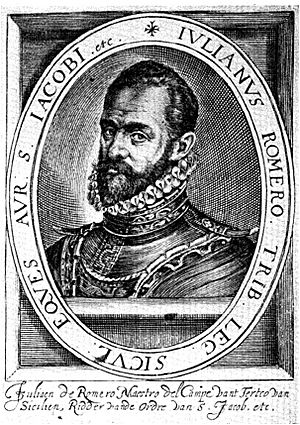Tercio of Sicily facts for kids

The Tercio of Sicily (which in Spanish is Tercio Viejo de Sicilia) was a very old and important military unit. It was one of the first "tercios" ever created. A tercio was a special type of army unit in Spain, like a large regiment.
This unit was formed in 1534 by Charles V, Holy Roman Emperor. The Spanish army still honors this unit's history today. Its main job was to protect Spanish lands in Italy from enemies.
The name "viejo" means "old" because it was one of the first three tercios ever made. It started with 12 companies, each having about 150 to 200 soldiers. The Tercio of Sicily was based in Sicily and other parts of Italy like Calabria.
Its first big mission was to capture La Goulette, a town controlled by the Ottoman Empire. They succeeded! From 1542 to 1544, the unit served in France and Piedmont. Later, in 1550, they fought many battles against the Ottomans. They even helped defeat the Ottoman forces in the famous Battle of Lepanto in 1571.
Between 1571 and 1588, the Tercio of Sicily fought in many places. They battled against Prince William the Silent in Flanders and against the Ottomans in Tunis. In 1580, they took part in the War of the Portuguese Succession. Sadly, in 1588, many soldiers from the tercio were lost when the Spanish Armada was destroyed.
In the early 1600s, the unit became known as the "Permanent Tercio of Sicily." This was because they had been stationed on the island of Sicily for 200 years. Even so, they still went on missions to fight the Turks and in France. Later in the 1600s, they helped stop rebellions in the Kingdom of Sardinia in 1699 and Messina in 1673.
History of the Regiment
In 1705, the Tercio of Sicily was reorganized into three smaller units. Two years later, it became a regiment with two battalions. A battalion is a large group of soldiers. In 1715, another battalion was added, and the unit was renamed the "Regiment of Africa."
Throughout the 1700s, the regiment moved around a lot in Spain. They were stationed in cities like Pamplona, Ceuta, Barcelona, and Madrid. They also fought in wars in Italy, Portugal, Spanish America, and North Africa. During this century, the unit faced three shipwrecks, which caused them to lose many soldiers. The last shipwreck happened in 1802 near Galicia.
During the Peninsular War (a big war in Spain), the Tercio of Sicily fought in many important battles. These included the battles of Bailén, Tudela, and Talavera.
Later, in 1837, the tercio fought in the First Carlist War at the battle of Huesca. They also fought in Africa in the battles of Tetuán and Wad-Ras. In 1873, during the Third Carlist War, they were involved in battles at Puente la Reina and Montejurra.
In 1893, the unit got its original name back: "Infantry Regiment 'Sicily' No. 7." In 1922, they took part in the Rif War, capturing areas like Tazarut. In May 1931, after the Second Spanish Republic was declared, the regiment became a mountain battalion. It was sent to Pamplona. Just before the Spanish Civil War in 1936, it was renamed "Mountain Battalion Sicily No. 8."
After the Spanish Civil War, the unit changed its name and structure several times. In 1966, it was called "Mountain Infantry Regiment Sicily No 67." It had battalions in San Sebastián and Irún. Later, it was renamed Regimiento de Cazadores de montaña Tercio Viejo de Sicilia. In 1994, to celebrate its 450th anniversary, it got its original name back: Regimiento de Infantería Ligera “Tercio Viejo Sicilia“ n.º 67. In recent years, soldiers from this unit have served in international missions. They have been in places like Bosnia Herzegovina, Lebanon, Kosovo, Iraq, and Afghanistan. Since 2016, it has been called Regimiento de Infantería “Tercio Viejo Sicilia“ n.º 67 because its battalion became motorized.
Current Insignia
This is the badge for the 1st-67 Motorized Infantry Battalion "Legazpi" I/67.
See also
In Spanish: Tercio Viejo de Sicilia para niños



